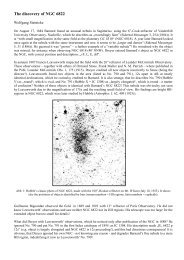John Louis Emil Dreyer – A Short Biography
John Louis Emil Dreyer – A Short Biography
John Louis Emil Dreyer – A Short Biography
Create successful ePaper yourself
Turn your PDF publications into a flip-book with our unique Google optimized e-Paper software.
Abb. 4: <strong>Dreyer</strong>’s 10" Grubb refractor at Armagh.<br />
<strong>Dreyer</strong>’s first concern was the instrumental upgrade of the observatory. To study nebulae, he required a midsized<br />
refractor. The 15" Grubb reflector (which had been erected in 1835) with a metal mirror was outdated, 9 but<br />
funding the new instrument <strong>–</strong> later called the ‘Robinson Equatorial’ <strong>–</strong> caused difficulties. Owing to <strong>Dreyer</strong>’s<br />
tenacity, the state, the church and the Royal Society eventually provided £2000 <strong>–</strong> however, under the condition that<br />
there should be no request for any further grants. <strong>Dreyer</strong> chose a 10" refractor by Grubb with a focal ratio of 1:12<br />
(Fig. 4). Since his great model d’Arrest had impressively demonstrated that such a modest aperture was sufficient to<br />
observe nebulae.<br />
<strong>Dreyer</strong> used the time while the instrument was being built for reducing Robinson’s star observations, which<br />
were completed by additional measurements with the meridian-circle. The result appeared in 1886 in Dublin as the<br />
Second Armagh Catalogue, containing positions of 3300 stars for the epoch 1875. The Grubb refractor, which was<br />
equipped with two micrometer eye-pieces (one without illumination), was ready to use on 28 July 1885. The dome,<br />
which was located in the observatory park south of the main building, has a diameter of 4.9 m.<br />
Besides observing nebulae, <strong>Dreyer</strong> carried on his catalogue work. In 1886 he offered the RAS a ‘Second<br />
supplement’ to the General Catalogue. Surprisingly, the Society refused it, favouring rather a completely new<br />
catalogue. <strong>Dreyer</strong> agreed and only two years later the work was published in the Memoirs of the RAS as the ‘New<br />
general catalogue of nebulae and clusters of stars’ <strong>–</strong> this is the famous NGC (<strong>Dreyer</strong> 1888). Afterwards, special<br />
objects (especially those supposed to be variable) were observed with the Grubb refractor. The results were<br />
published in 1894 in the Transactions of the Royal Irish Academy, giving positions and notes to 100 nebulae. By<br />
and by a growing number of new nebulae and star clusters were discovered <strong>–</strong> partly by photography. Thanks to the<br />
NGC, the rising interest in non-stellar objects brought a considerable amount of corrections. <strong>Dreyer</strong>, accurately<br />
following the issue, thus created two additional works: the Index Catalogues, which were published in the Memoirs<br />
(<strong>Dreyer</strong> 1895, 1908). He also wrote various articles about nebulae. He was also interested in double stars, but his<br />
observations remained unpublished.<br />
As an assistant in Dunsink, <strong>Dreyer</strong>’s main duty was astrometry, but in Armagh, being now the director, he<br />
had complete freedom to do whatever he liked. After the legacy of the Second Armagh Catalogue, he focused not<br />
only on nebulae but also on another subject that would eventually become most important: the history of<br />
astronomy. As early as in 1883 <strong>Dreyer</strong> had written a ‘Historical account of the Armagh Observatory’, which was<br />
published in Liverpool (<strong>Dreyer</strong> 1883), but his main interest, originating from his youth, related to his home country<br />
Denmark and its great astronomer Tycho Brahe. In 1890 he published in Edinburgh a biography titled Tycho Brahe,<br />
a Picture of Scientific Life and Work in the Sixteenth Century. The 405-page book is still a standard work. There he<br />
described the importance of historical studies: ‘Astronomers are so frequently obliged to recur to observations<br />
made during former ages for the purpose of supporting the results of the observers of the present day, that there is<br />
a special inducement for them to study the historical development of their science.’<br />
Though Armagh Observatory hosted a respectable library, which had been set up by Robinson, it was not<br />
sufficient for <strong>Dreyer</strong>’s historical research. Thus he often visited Dun Echt Observatory in Scotland. Its ‘Crawford<br />
Library’, which had been amassed by Lord Lindsay, was a unique treasure of rare old books. After the closure of<br />
the site in mid 1890, the instruments and library found a new home at the Royal Observatory Edinburgh on<br />
9 Glass (1997): 17-19.











![SFB2011 Zeit [Kompatibilitätsmodus]](https://img.yumpu.com/4636501/1/190x135/sfb2011-zeit-kompatibilitatsmodus.jpg?quality=85)